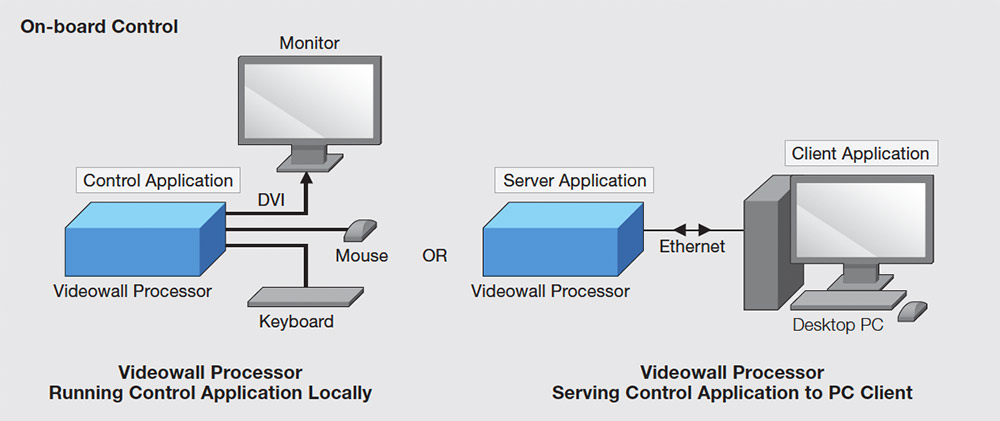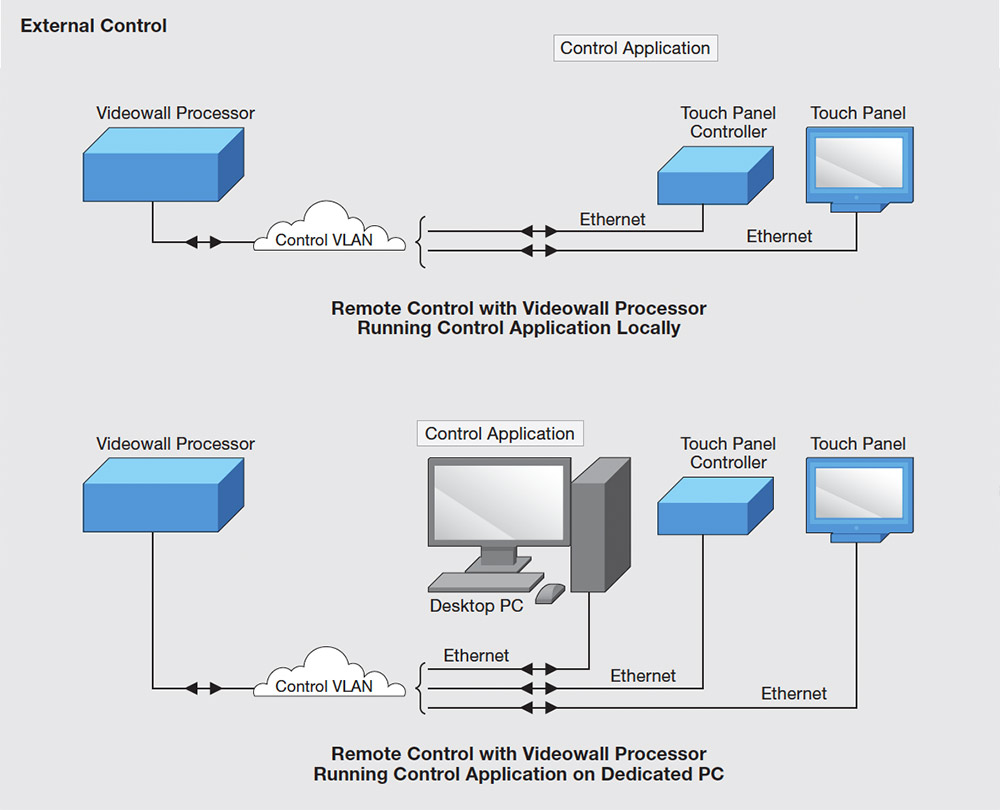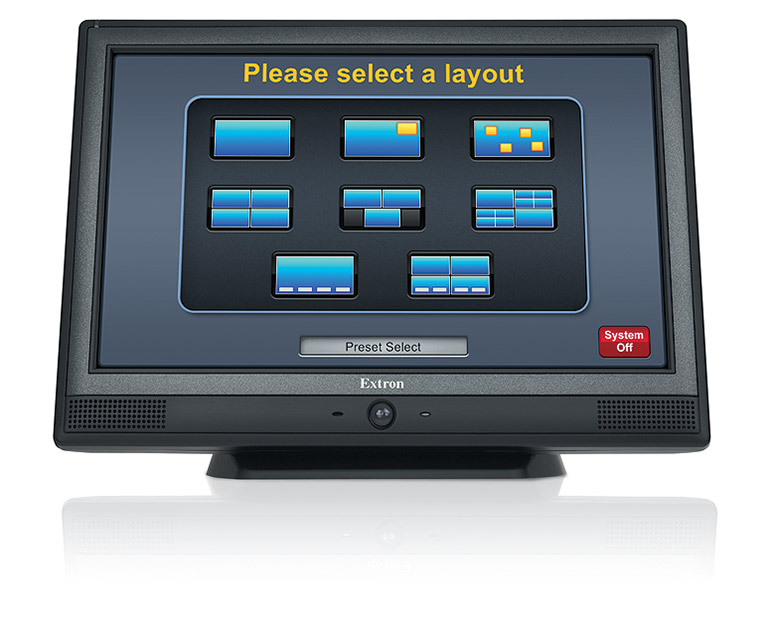Videowall System Control
Videowalls are among the most complex types of AV systems to set up and configure. Most of the operational complexity is within the videowall processor and its many functions, features, and capabilities. Working with a videowall processor will be greatly simplified if an intuitive, user-friendly interface is available for system configuration and creating window layouts. The more intuitive the interface, the more streamlined the setup and configuration process will be.
Videowall system designs should include consideration for the end user interface, in terms of how staff will operate the videowall. Videowall control should streamline the user’s workflow. This may be accomplished by providing a touchpanel with simple button selections for window presets or input sources, or by tying these functions into control room system management software.
Working with a videowall processor will be greatly simplified if an intuitive, userfriendly interface is available for system configuration and creating window layouts.
Basic Control
Small, simple videowall processors can be configured and operated from a front-panel interface that provides access to all of its setup and control functions. Some processors can also be configured through their internal Web pages, accessed by a client Web browser over the network or the Internet.
Control Application Software
Most videowall processors require use of specialized application software for setup and configuration. For a PC-based processor, the application can usually be run on the unit itself, while for other processors, a PC runs the software and connects to it as a client. See Figure 3-12.

Rather than making the application software available to end users, it is usually preferred to create a simplified control interface with a series of button selections, so a user only needs to control the most common or essential functions on a videowall.
The application software aids in navigating through the many functions and features for videowall processing. It includes a GUI and usually groups controls and functions into a logical organization of essential tasks, such as configuring the inputs for incoming source signal formats, defining the videowall configuration and setting up the displays, and creating and saving window layouts. The application software includes a virtual canvas that lets you visualize the window layout as it is being created and drag-and-drop windows onto or off the canvas.
Dedicated PC for Setup and Control
For most videowall processors, the software is no longer required once configuration is complete. However, some videowall processors, notably the Extron Quantum Elite and Quantum Connect require that a PC be connected at all times with the application running. See Figure 3-13. The PC is not just an interface for a user, but also initiates control commands to the processor. Compared to PC-based videowall processors that run the control application internally, the use of an external PC isolates control functions from on-board processing resources. This eliminates operational load on the CPU, optimizing response time and speed when recalling window presets or performing other operations, especially with large systems.

Remote System Control
Videowall processors can be controlled using the application software, or a control system through the RS-232 or Ethernet control ports. For the Quantum Elite and Quantum Connect processors, the PC running the application software serves as the interface to the control system.
While the application software can be used for system control, the user interface usually includes far more functions and options than necessary for a staff member or system operator, often without detailed knowledge of working with the system. Rather than making the application software available to end users, it is usually preferred to create a simplified control interface with a series of button selections, so a user only needs to control the most common or essential functions on a videowall – selecting an input source or a pre-programmed window preset. This can be provided through a custom GUI from a touchpanel, or custom software interface created by the application software or other third-party software managing control over other processes. See Figure 3-14.

Large Facility Control
Many large facilities, such as command and control rooms require that management of all communications including AV be centrally integrated into a single control system. This allows multiple room operations to be performed from a common GUI. The system can be programmed to incorporate videowall window layout and input source selection, with buttons provided in the user interface alongside other communications functions. Videowall-specific controls may also be provided separately on a touchpanel for an AV control system.
For most videowalls applied in working environments such as presentation rooms, control rooms, and retail or signage displays, simple user controls will suffice for staff or a system operator to manage the display.
On-Demand vs. Show Control
For most videowalls in working environments such as presentation rooms and control rooms, simple user controls will suffice for staff or a system operator to manage the display. However, entertainment-oriented applications call for elaborately timed, dynamic presentations, which may require a system operator to be trained in the use of show control software that provides access to a wide, free-flowing set of time-based effects. The ideal control method will depend on the environment and application requirements defined by the end user.

On-Demand Control
In work environments or live entertainment applications, changes to the videowall typically are triggered “on-the-fly” by an operator or end user. Recalling window presets and changing source window content are the most frequent actions performed on the videowall.
End users often communicate that they want access to control “everything” and be to able to place any image anywhere on a videowall, but are unaware of the complexity of managing the system. In most cases, five to ten pre-defined window layouts, plus the ability to change source window inputs provides the flexibility they require. Other potentially desirable tools may include source identification or labeling, window borders, image zooming, and other functions. These are best programmed and made available as button presets.
Show Control
Videowalls used in retail stores, museums, or other public spaces often include specially created productions that include presentation of looped video content, with creative visual effects timed to video edit points or events in the content. To coordinate videowall actions with the content, an audible SMPTE or EBU timecode signal is recorded onto one of the audio tracks for the content. This is supplied to a PC running a show control application to provide the time reference for initiating commands, as well as a reference for actions on other show control devices. The show control computer releases control commands to the videowall processor or its control PC, triggered by the incoming timecode signal.
